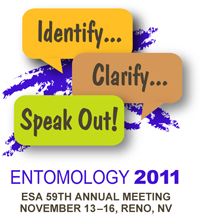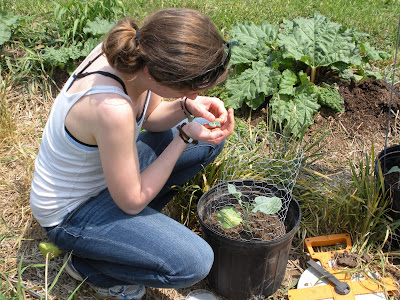Obviously we were productive as we are now at the Entomological Society of America meeting in Reno, NV, presenting various presentations and posters. Our aims are obviously to shock and awe! (or just bring awareness to our awesome projects)


 For surveying biological control services that occur above or on the ground we used three methods: Larvae on sticky cards, larvae hanging in cages, and aphid counts.
For surveying biological control services that occur above or on the ground we used three methods: Larvae on sticky cards, larvae hanging in cages, and aphid counts.
 The final method, aphids, is a method that is commonly used to asses biological control services in fields. This method involves placing plants infested with aphids in the field. One is covered with a net to exclude predators, but still be affected by the weather conditions. The other plant is left open (without a net) so predators are able to munch away on the aphids as they please. The idea is to compare the number of aphids on that closed plant with the number of aphids on that open plant after a period of time in the field (one week in our case) to get an idea of the effect predators have on aphid colonies. We would expect to have higher aphid counts in the closed plant treatments.
The final method, aphids, is a method that is commonly used to asses biological control services in fields. This method involves placing plants infested with aphids in the field. One is covered with a net to exclude predators, but still be affected by the weather conditions. The other plant is left open (without a net) so predators are able to munch away on the aphids as they please. The idea is to compare the number of aphids on that closed plant with the number of aphids on that open plant after a period of time in the field (one week in our case) to get an idea of the effect predators have on aphid colonies. We would expect to have higher aphid counts in the closed plant treatments.


 This summer the ALE lab is working with the Cleveland Metroparks to study insect communities in some of the park's forests. The Metroparks have established 30 plots in beach maple forests throughout their system where they have completed and intensive inventory of plant diversity and relative abundance. Within each of these plots our lab will determine if the insect fauna is influenced by the quality of the plant community found. We are mainly interested in measuring beneficial insects including predators and parasitoids.
This summer the ALE lab is working with the Cleveland Metroparks to study insect communities in some of the park's forests. The Metroparks have established 30 plots in beach maple forests throughout their system where they have completed and intensive inventory of plant diversity and relative abundance. Within each of these plots our lab will determine if the insect fauna is influenced by the quality of the plant community found. We are mainly interested in measuring beneficial insects including predators and parasitoids. The first few weeks of field work each spring usually involve some last-minute changes of plans. This year is no exception. Today Scott Prajzner began the first of three experiments to measure pollinator activity within vacant lots and urban gardens in Cleveland. Today we took 48 blooming sunflowers to 8 sites. Scott is using the sunflowers to measure pollination services. He will collect them in 7 days and compare seed set in flowers which were exposed to pollinators with those that were bagged to prevent pollinators from accessing them. He will then determine if the pollination services supplied to vacant lots or urban gardens is significantly different. In addition to using the sunflowers to measure pollination services we also planned to monitor the community of bees visiting the plants within each site. We also plan to measure bee activity at other flowering plant species within each site.
The first few weeks of field work each spring usually involve some last-minute changes of plans. This year is no exception. Today Scott Prajzner began the first of three experiments to measure pollinator activity within vacant lots and urban gardens in Cleveland. Today we took 48 blooming sunflowers to 8 sites. Scott is using the sunflowers to measure pollination services. He will collect them in 7 days and compare seed set in flowers which were exposed to pollinators with those that were bagged to prevent pollinators from accessing them. He will then determine if the pollination services supplied to vacant lots or urban gardens is significantly different. In addition to using the sunflowers to measure pollination services we also planned to monitor the community of bees visiting the plants within each site. We also plan to measure bee activity at other flowering plant species within each site.










 http://bugguide.net/node/view/60915/bgimage: Copyright © 2006 Sean McCann
http://bugguide.net/node/view/60915/bgimage: Copyright © 2006 Sean McCann Subduction earthquakes result when the upper plate "catches" on the lower plate as the lower plate moves beneath it. Over time, the upper plate slowly bends until enough pressure builds and it breaks free. Very quickly, a high volume of water is sent straight up from the sea floor (video 1). Japan experienced the massive tremors from being on the upper plate, in a sort of springboard effect.
Subduction earthquakes result when the upper plate "catches" on the lower plate as the lower plate moves beneath it. Over time, the upper plate slowly bends until enough pressure builds and it breaks free. Very quickly, a high volume of water is sent straight up from the sea floor (video 1). Japan experienced the massive tremors from being on the upper plate, in a sort of springboard effect.


 http://callprobest.com/blog/2010/08/in-the-desert-the-tarantula-hawk-probest-pest-blog
http://callprobest.com/blog/2010/08/in-the-desert-the-tarantula-hawk-probest-pest-blog http://bugguide.net/node/view/325482 : Lori
http://bugguide.net/node/view/325482 : Lori

 http://en.wikipedia.org/wiki/File:Four-spotted_Skimmer.jpg
http://en.wikipedia.org/wiki/File:Four-spotted_Skimmer.jpg

 http://www.cirrusimage.com/Beetles/7-spotted_ladybird_3.jpg
http://www.cirrusimage.com/Beetles/7-spotted_ladybird_3.jpg